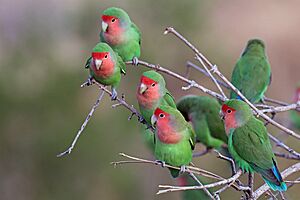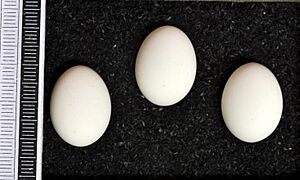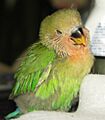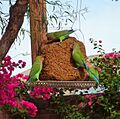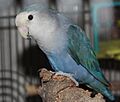Rosy-faced lovebird facts for kids
Quick facts for kids Rosy-faced lovebird |
|
|---|---|
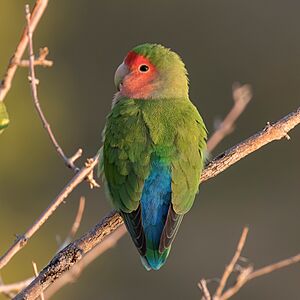 |
|
| in Erongo, Namibia | |
| Conservation status | |
| Scientific classification | |
 |
|
| Native ranges in the Namib Desert and arid areas of Namibia and Angola |
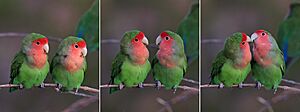
The rosy-faced lovebird (Agapornis roseicollis), also called the rosy-collared or peach-faced lovebird, is a type of lovebird. These birds live in dry areas of southwestern Africa, like the Namib Desert.
Rosy-faced lovebirds are very social. They often gather in small groups in the wild. They are known for being loud and chirping a lot. These birds eat all day and love to take baths often. Their colors can be different depending on where they live. Both male and female lovebirds have the same colors.
Lovebirds are famous for how they sleep. They sit close together and turn their faces towards each other. Female lovebirds are also known for tearing materials into long strips. They then carry these strips on their backs to build nests, even flying long distances! You can often find these birds as pets.
Contents
About Rosy-Faced Lovebirds
What's in a Name?
The rosy-faced lovebird was first described in 1818 by a French bird expert named Louis Pierre Vieillot. He first called it Psittacus roseicollis. Later, it was moved into the Agapornis group, which includes all other lovebirds.
There are two main types, or subspecies, of rosy-faced lovebirds:
- Agapornis roseicollis (Vieillot, 1818)
-
- Agapornis roseicollis catumbella (B.P. Hall, 1952) - This type lives in Angola.
- Agapornis roseicollis roseicollis (Vieillot 1818) - This type lives in Namibia, Botswana, and South Africa.
How They Look
The rosy-faced lovebird is a fairly small bird. It is about 17–18 cm (6.7–7.1 in) long. Its wings are about 106 mm (4.2 in) long, and its tail is about 44–52 mm (1.7–2.0 in) long.
Wild lovebirds are mostly green with a blue bottom (rump). Their face and throat are pink, with the darkest pink on their forehead and above their eyes. They have a horn-colored beak, brown eyes, and gray legs and feet. The pink color of the A. r. roseicollis type is lighter than the A. r. catumbella type. Young lovebirds have a pale pink face and throat. Their forehead and top of their head are greenish, and their beak has a brownish base.
Where They Live and Their Home
Their Natural Home
Rosy-faced lovebirds live in dry, open areas in southwest Africa. Their home range goes from southwest Angola, across most of Namibia, to the lower Orange River valley in northwest South Africa. They can live up to 1,600 metres (5,200 ft) above sea level. They prefer woodlands, semi-deserts, and mountains. These birds always need to be near water sources, so they gather around pools to drink.
Lovebirds Around the World
Sometimes, pet lovebirds escape from their homes. Because of this, you can find wild lovebirds in many parts of the world. For example, there are wild lovebirds living in Phoenix, Arizona, in the United States. They live in cities and in the countryside. Some live in cacti, and others visit bird feeders in large groups.
Temperatures in Arizona can often go above 40 °C (104 °F). Wild lovebirds have been seen sitting on air-conditioner vents to stay cool! You can also find wild rosy-faced lovebird groups on Maui and the Big Island in Hawaii. They have also been seen in Puerto Rico, but these are likely escaped pets, and they haven't been seen having babies there.
How They Are Doing
In some areas, people have caught many lovebirds for the pet trade. This has made their numbers go down. However, in other places, their numbers might have grown. This is because humans have created new water sources and built structures that offer new places for them to nest. Because of this, the International Union for Conservation of Nature (IUCN) says the species is of Least Concern. This means they are not currently in danger of disappearing.
How They Behave in the Wild
Rosy-faced lovebirds make loud, harsh, shrieking calls.
What They Eat
Their diet is mostly made up of seeds and berries. When there is a lot of food, hundreds of these birds might gather together. Sometimes, they can be a problem for farmers. They might eat crops like millet.
Reproduction
Male and female lovebirds look alike. This is called being monomorphic. They build their nests in cracks in rocks. They also use parts of the large shared nests built by sociable weavers. Sometimes, they even use human-made places like house roofs.
A female lovebird usually lays 4 to 6 eggs between February and April. The eggs are a dull white color and measure about 23.5 by 17.3 mm (0.93 by 0.68 in). The eggs are kept warm, or incubated, for about 23 days until they hatch. The young birds are ready to fly, or fledge, after about 43 days.
Keeping Lovebirds as Pets
Rosy-faced lovebirds are one of the most common parrots kept as pets. This is because they are small and easy to care for and breed. People usually keep them alone or in pairs. But because they are very social, it's best to keep them in pairs.
Lovebirds can sometimes be aggressive. They tend to bond very strongly with one person or another bird. They might not get along well with other people or pets. Sometimes, two lovebirds might not get along and need to be separated. Lovebirds should also not be kept with smaller types of birds. Pet lovebirds need to get daily exercise.
- Captive bred birds
-
Wild lovebirds eating seeds from a garden feeder in Arizona, USA
Cool Color Changes
Rosy-faced lovebirds have the most different color changes, or mutations, of all the Agapornis genus (group of birds). These color changes happen because of different genes. They can be dominant, codominant, recessive, or sex-linked recessive. This might sound a bit tricky, but it just means that a single bird can have many different color traits at once!
- Colour varieties in aviculture



